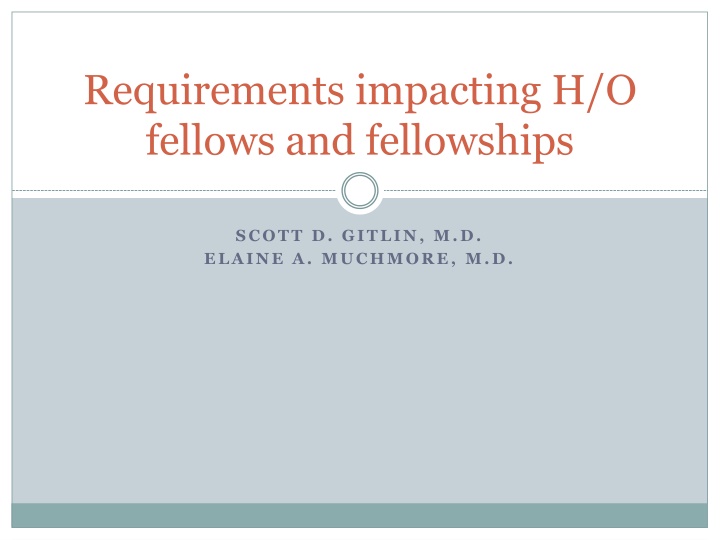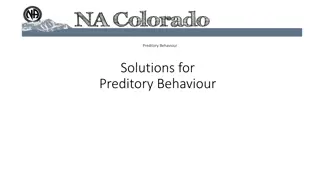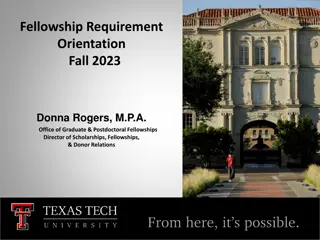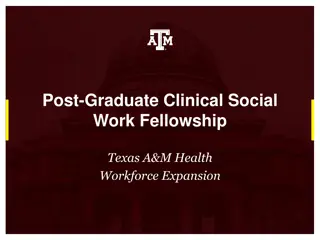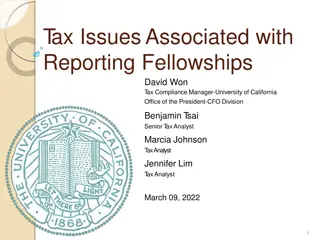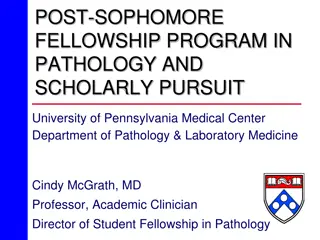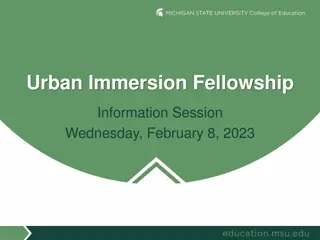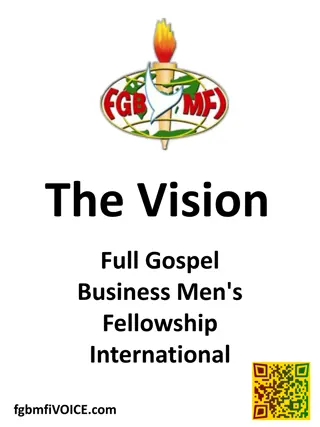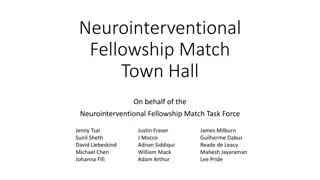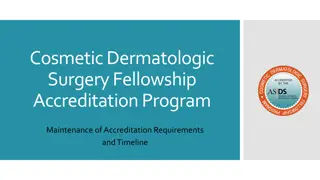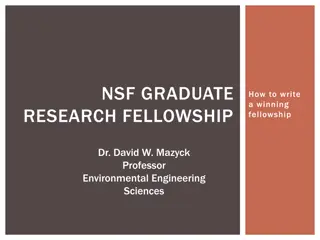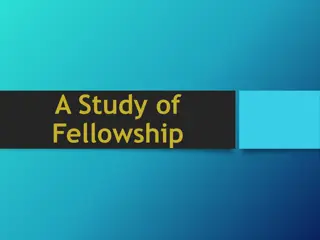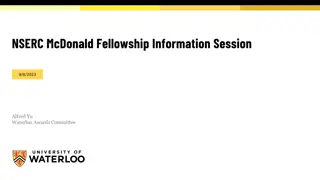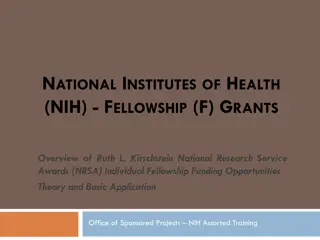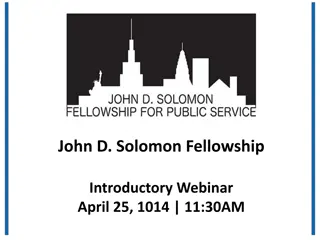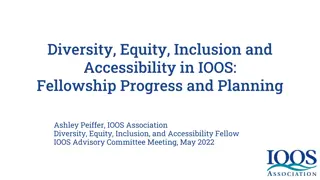Impact of Fellowship Regulations: Changes and Implications
Planned changes in residency and fellowship regulations, institutional approaches, downstream implications for fellowships, ACGME newsletter clarifications, and annual survey updates for both core and specialty programs.
Download Presentation

Please find below an Image/Link to download the presentation.
The content on the website is provided AS IS for your information and personal use only. It may not be sold, licensed, or shared on other websites without obtaining consent from the author.If you encounter any issues during the download, it is possible that the publisher has removed the file from their server.
You are allowed to download the files provided on this website for personal or commercial use, subject to the condition that they are used lawfully. All files are the property of their respective owners.
The content on the website is provided AS IS for your information and personal use only. It may not be sold, licensed, or shared on other websites without obtaining consent from the author.
E N D
Presentation Transcript
Requirements impacting H/O fellows and fellowships SCOTT D. GITLIN, M.D. ELAINE A. MUCHMORE, M.D.
Disclosures for Scott Gitlin, MD and Elaine Muchmore, MD In compliance with ACCME policy, ASH requires the following disclosures to the session audience: None Employment None Consultancy None Equity Ownership None Research Funding 52nd ASH Annual Meeting Orlando, FL None Honoraria None Patents & Royalties None Speakers Bureau None Membership on Board of Directors/Advisory Committee None Other None Presentation includes a description of the following off-label use of a drug or medical device
Scott Gitlin, MD Former H/O TPD Former Hematology PD representative, ASP Council Treasurer, ASP Council Elaine Muchmore, MD Former H/O TPD Current IM TPD ASH representative, ASP Council
Our focus Review of planned changes in residency and fellowship regulations Two institutional approaches to these changes Anticipated downstream implications for fellowships
Planned changes to fellowships ACGME Newsletter clarifications (August, 2010) Newsletters from RRC-IM will be published twice yearly Multisource (aka 360o) evaluations must include patients, peers, and non-physician team members (nurses, clerical staff, therapists) that assess interpersonal and communication skills, professionalism, systems-based practice IM PD may not also serve as specialty PD Specialty programs with proposed or confirmed withhold of accreditation action in 2009 (n=32) revealed that most contained the following citations: inadequate faculty scholarship (participation and/or productivity) no evidence that key clinical faculty have current ABIM certification inadequate core conferences.
Planned changes to fellowships ACGME Annual survey Announced at AAIM meeting in October that programs with responses on annual survey >2 SD from national mean will receive warnings or decreased cycle length Time-line for change in reporting by ACGME on annual survey in new format not clarified ACGME responses would be graduated, based on number of categories of deficiencies, but may result in accelerated site visit For both core and specialty programs with >5 residents/fellows (n=6000), approximately 35 were sent letters announcing shortened cycle length Annual institutional visits by ACGME Announced, but no published details about depth and breadth of visits (institutional cost anticipated to be $12-14K, so anticipated to be multiple day visits)
Planned changes to fellowships ABIM Will allow PD discretion for fellows with excused absence of <1 month (in addition to vacation) over course of training program. ACGME aligned with this change.
Past and pending changes in IM residency training Several major changes, past and impending ABIM Procedure requirements for IM residents Implications already discussed at length in previous sessions of this group, but the implication is that all fellowships must assess procedural competence of new fellows ACGME Maximum shifts for interns 16 hours, 24+4 for residents Several requirements to educate residents and faculty members about fatigue and safety issues Requirement for standardized procedures for handing over patient care Requirement that programs offer sleep facilities and/or transportation after residents have overnight shifts Requirement for annual site visits by the ACGME to assess the implementation of the planned changes SO HOW WILL THESE CHANGES AFFECT FELLOWS?
Downstream effects More costs attributable to residency training As much as $1 billion (Nuckols and Escarce, 2010) Concern that increased inpatient shifts may result in fewer specialty rotations for residents Inpatient: outpatient ratio unchanged so will depend upon IM program structure Concern that subspecialty fellows will be required to do more scut Less of a problem for non-procedural specialties such as H/O!?
Our focus Review of planned changes in residency and fellowship regulations Two institutional approaches to these changes (U of Michigan and UCSD) Anticipated downstream implications for fellows and fellowships
University of Michigan IM Residency VALUES & ANTICIPATED CHANGES Currently, an Intern-focused program Believe in educational role for overnight call for HO Is (q4day) Impact of new duty hours regulations: 48 call nights = 8 HOI FTEs and 900-1000 discharges/year Goal will be to preserve an educational experience with night work Do not want shift work model Intend to maintain a subspecialty service emphasis at UM Hospitals General Medicine with subspecialty consultation model at VA unchanged Preserve teamwork format Resident-run services Promote autonomy Preserve comprehensive, safe, high quality patient care
University of Michigan IM Residency VALUES & ANTICIPATED CHANGES Data to Be Collected, Monitored and Evaluated Service evaluations Confirm that end-product is well-trained generalist Faculty interaction and exposure with residents
University of Michigan IM Residency ANTICIPATED CHANGES---MODEL University Hospital Close down a subspecialty (not Hem/Onc) inpatient service These admissions will go to either a Hospitalist-run General Medicine service or to a subspecialty-oriented Hospitalist-run service (non-teach) Current open CCU will close and will have floor-status patients cared for by other services Shift of FTEs from Cardiology floor service to other services Consult services No jeopardy pulls for the consult services, BUT No guarantee of 12 months of H/O service coverage VA Current: 2 HO Is + 1 HO II/HO III; M3 and M4 medical students New: 1 HO I + 1 HO II/III make a team that will work 14-16 hours and then covered by a night float model with a HO I + HO II/III night team staffed by an in-house Hospitalist who will provide clinical oversight and teaching at night. A night-time curriculum will be developed ICUs will also have a day team and a night team
University of Michigan IM Residency ANTICIPATED CHANGES---FELLOWSHIPS Many will be requesting approval and funding for an increased number of fellowship FTEs Recognized that fellowship programs will also need to focus on education and not scut work Recognized that fellows programs need to be focused on education and not on scut work Fellows likely to take on an increased patient care work load Faculty may need to take on an increased hands-on patient care work load Some services likely to request approval and funding for mid-level providers to provide care on consultation and inpatient services
University of Michigan IM Residency ANTICIPATED CHANGES---COSTS For the core residency program changes Estimated: $1.5 2.0 Million (to start with)
UCSDs IM residency AY10-11 Overview: 92 residents (smaller than UM, which has 124) 3 hospital system: VA, University-run county-style and private- style hospitals Current rotations All teaching services call is q4, and overnight Rotations front-loaded for R1s: 9 mos. ward/ICU for R1s, 6 mos. R2s, 3 mos. R3s 1 Non-teach service at each of University hospitals (recent). Nocturnists at University hospitals for over-flow/non- teach/nocturnal supervision VA mostly resident-run: ED physicians do admissions after midnight so teams can close
UCSDs IM residency, AY11-12 Proposed changes Inpatient Wards: Composed primarily of day admitting teams (1 resident, 2 interns). No overnight call. Night float team of residents and interns Critical Care: MICU, VICU, CVC 4 residents and 2 interns Maintain Q4 overnight call for the residents Preserved continuity clinics, electives, and ambulatory rotations This seems reasonable! How is this different from AY10-11?
UCSD IM residency AY11-12 The big issues raised by this inpatient structure Previously residents covered 13 inpatient teams; starting AY11- 12, they will cover 8 Hospital Medicine had recruited academic hospitalists; now these hospitalists will have non-teach services >50% of the time Medical school has increased class size, with peak number of third year students during AY11-12, and there are fewer teaching teams (resulting) Costs Huge political cost >$1.5 million in personnel costs
Overview of presentation Review of planned changes in residency and fellowship regulations Two institutional approaches to these changes (U of Michigan and UCSD) Anticipated downstream implications for fellows and fellowships
Downstream consequences to fellows and H/O fellowships Few short-term changes for fellowships More costs attributable to IM residency training, due to coverage of non-teach services (and increased residents) Concern: will there be less interest in/availability of institutional funding for subspecialty fellows? Same projected residency competence level in decreased training time Concern: insufficient clinical time and diversity will decrease quality of IM training experiences Response from many programs will be to invert current training pyramid , in which senior residents have decreased ward rotations Concern: TPDs will not be able to assess capabilities of R2s for current ERAS/NRMP cycles (some IM TPDs have stated that R2 year should not commence until after 15 mos of training!) Too early to tell whether major problems in IM training will occur
Additional H/O fellowship topics So were do we stand on fellowship applications? Applications to H/O fellowship 2005-10
Certified fellowship positions 2009 H/O Oncology Hematology 0 50 100 150 200 250 300 350 400 450 500
Demographics of matched/unmatched applicants 2009 IMGs US-foreign US H/O IMGs US-foreign US Hematology 0 10 20 30 40 50 60 70
Summary of ERAS data Applications for Hematology and Oncology fellowships have decreased, perhaps because number of separate training programs has decreased H/O fellowship relatively stable although there has been a slight increase since 2006 (in approximately same USMG/IMG ratio) More Asian than white applicants!
